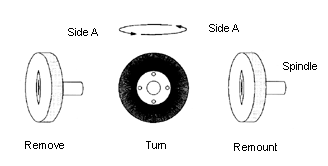Safety Guide
Power Brush Safety Requirements
Warning - In normal power brushing operations, the material being removed, such as burrs, scale, dirt, weld slag, or other residue, will fly off the brush with considerable force along with brush filaments which break off due to fatigue.The potential of serious injury exists for both the brush operator and others in the work area (possible 50 or more feet from the brush). To protect against this hazard, wear safety goggles or full face shields worn over safety glasses with side shields, along with protective clothing.
You must follow all operator and safety instructions, as well as all common safety practices which reduce the likelihood of physical injury, or reduce its severity.
Summary-Power Brush Safety Requirements
Safety Goggles - Safety goggles or full face shields worn over safety glasses with side shields must be worn by ALL operators and others in the area of power brush operations. Comply with the requirements of ANS Z87.1-1979 "Occupational Eye and Face Protection."Guards - Keep all machine guards in place.
Speeds - Observe all speed restrictions indicated on brushes, containers, labels, or printed in pertinent literature. "MSFS" means Maximum Safe Free Speed (RPM) - spinning free with no work applied. For reasons of safety "MSFS" should not be exceeded under any circumstances.
Safety Standard - Comply with the Safety Standards of the Industrial Division of the American Brush Manufactures' Association and the American National Standards Institute ANSI B165.1 - 1985 - Safety Requirements - Power Brushes and ANSI B165.2 - 1982 "Safety Requirements - Power Brushes - Wood, Plastic, or Composition Hubs."
Protective Equipment - Appropriate protective clothing and equipment must be used where there is a possibility of injury that can be prevented by such clothing or equipment.
Warning! Failure to observe safety precautions may result in injury.
Brush Usage Recommendations
Pressure - Avoid excessive pressure when using a power brush. Excessive pressure causes over-bending of the filaments and heat built-up resulting in filament breakage, rapid dulling, and reduced brush life. Instead of greater pressure on a brush, it is suggested that you try: 1) a brush with a more aggressive cutting action (increased wire size decrease filament length, change to a different brush type, i.e., knot type instead of crimped wire type), or 2) higher speed (increased R.P.M., increased brush diameter.)Important Note: Never exceed the recommended Maximum Safe Free Speed R.P.M. (MSFS) rating of the brush.
Brushing Problems - Do Not Allow Unsafe Conditions To Continue. Occasionally, due to worn bearings, a bent spindle, an unusual application, operator abuse, or inappropriate use, a brush may fail. A brush which is not received in acceptable condition for trouble-free operation may also fail. Do not use or continue to use a failed brush or one which is functioning improperly (i.e., throwing filaments, out-of-balance etc.) as this increases the possibility for further brush failure and hazard of injury. The cause of the failure should be evaluated and corrected.
This information is based on the collective experience of the ABMA Industrial Division members and provided solely as a public service for the guidance of the users of the members' products. These recommendations are not necessarily complete with respect to any particular application and common sense safety considerations should be adhered to generally. Any applicable federal, state, local law or regulation, must be strictly adhered to, and is controlling over any recommendation contained herein.
Safety Instructions
Flex-Hone® and Twisted-In-Wire BrushesThe Flex-Hones and Twisted-In-Wire brushes, used under power, shall be securely held in a collet, chuck or similar holding device.
The operator shall secure the unit being honed or brushed and position all guards before starting the tool. The arrangement of the workplace shall ensure rotation of the brush on the true centerline to avoid deflection that may instantly multiply to destructive bending.
The shank of a Twisted-In-Wire brush and/or Flex-Hone®, because of its basic construction, is not inherently as strong as the shank on most other brushes.
Therefore, it is even more important that the tool length be no longer than necessary to perform the work, and that other conditions of use avoid load applications and speed of rotation that will cause the shank to deflect, and therefore bend, instantly resulting in total destruction of the brush and creating an unsafe condition for the operator.
Safety First
Failure to observe any requirements shown in the safety section will create safety hazards and can cause injury.Incorrect
Excessive pressure can cause wire breakage.

Correct
Tips doing the work...

Self-Sharpening - When using wire wheel brushes, periodically reverse the direction of rotation to take advantage of the self-sharpening action that will result. This may be accomplished by removing the brush from the spindle and turning it side for side, and remounting securely.





